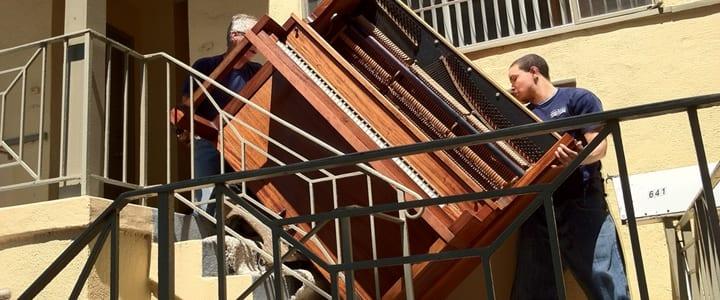When you own a piano, moving takes a bit more planning. Should you hire a professional, or do it yourself? Here, Helendale, CA teacher Sylvia S. shares what to keep in mind to make sure your instrument stays safe and sound…
Many years ago, when my family relocated, the expertise for moving our household grand piano was delegated to professional furniture movers. Three piano legs and the pedals console were removed and wrapped in blankets. The moving parts for the body, including the music stand, the keyboard cover, and the hinged top of the grand piano were secured. All this was wrapped in thick blankets and put into a piano case.
We thought all was well, until the piano arrived in our new home… with a huge bolt driven through the piano case. When the case was opened, we discovered the bolt was driven through both the piano and the soundboard. If you have ever considered hiring professionals for your piano moving, this is probably your worst nightmare.
How to Safely Move Your Piano
For cross-town relocations, a professional piano mover is usually your best bet for a grand piano. In long-distance relocations, it’s best to have a professional who deals exclusively with pianos to disassemble your piano and pack it carefully before involving furniture movers. Some piano companies will also move the piano for you. This may mean that two separate companies are involved in packing, and it’s a good idea to check the paperwork to be sure who will be responsible for delivering the piano in the same condition it left.
Although upright pianos have fewer moving parts than grands, and don’t require disassembly, it’s still a good idea to find a piano mover. Many pianos are much heavier than they appear and, if you’re a do-it-yourselfer, you may appreciate having help loading it into a rental truck.
Considerations for Storing Your Piano
If you need to store your piano during your move, there are extra things to consider. Since many important parts of the piano are made of wood, which is subject to expansion, the temperature extremes can ruin the instrument. Store your piano in a conditioned space, away from damp places. Don’t even think about putting your piano into a metal storage shed! It may be better to sell a piano in excellent condition, and just put that money away to buy another piano in the future.
Before your piano comes out of storage, think about where you will want to practice and play music. Look at the windows, walls, doors, and floor. Despite having insulation, an exterior wall is not the best choice for a piano. Look for an interior wall, with conditioned rooms on both sides. And, although it’s nice to have light from a window, take care that the piano will be protected from excessive heat, drafts, and rain.
Pianos in basements and garages may seem like a good idea to parents who are tired of hearing their kids practice. However, consider whether this is a good choice for an investment that can range in value from a few hundred dollars for a used spinet to hundreds of thousands of dollars for a new top-of-the-line grand piano. Consider placing a rug under the piano, particularly if the piano will be on a cold surface like tile, and definitely avoid putting your piano on a bare concrete floor.
Getting Back to Playing
Now that you know where your piano will be placed, it’s time to call in the piano moving professionals! Grand pianos will need to be reassembled, and your piano will need to be tuned; pianos can’t be expected to hold their pitch during relocation. It’s a nice idea to pencil in an annual appointment with a good piano tuner to keep things sounding good.
So, now that you know about storing and moving pianos, what happened to that piano I mentioned in the beginning of the article? Well, fortunately my great-grandfather was a piano tuner, and my dad was pretty handy with tools. My dad took a good look at the crack left in the soundboard by the bolt, bought several bottles of wood glue, and borrowed an amazingly huge wood clamp and a book from the library about piano rebuilding.
Watching as my dad glued the piano together and tightened the clamp, our family prayed for the resurrection of our beloved grand piano. The piano stayed clamped together for about a week while we refinished the exposed, cosmetic woodwork to a painted, antiqued look. My dad took apart and reassembled that piano piece by piece, learning how a grand piano is put together and tuned. Finally, in a suspenseful moment which seemed like an eternity, with our family as his audience, he carefully unscrewed the clamp. It held!
Although this is very unlikely to happen to you, it’s an example a worst-case scenario during piano moving. Don’t worry too much — make sure you hire a professional piano mover, and good luck with your piano adventures!
 Sylvia S. teaches singing, piano, theater acting, and more in Helendale, CA. She comes from a musical family of several generations, and her experience includes playing an electric keyboard and singing vocals in a professional, working band. Learn more about Sylvia here!
Sylvia S. teaches singing, piano, theater acting, and more in Helendale, CA. She comes from a musical family of several generations, and her experience includes playing an electric keyboard and singing vocals in a professional, working band. Learn more about Sylvia here!
Photo by Colin Kinlund
Suzy S.

